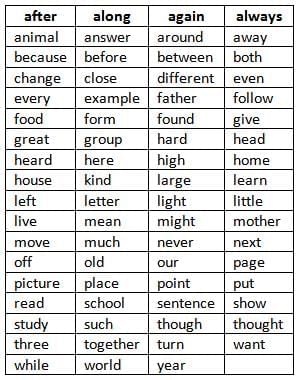Sight words Chapter Notes | Language Arts for Grade 1 PDF Download
| Table of contents |

|
| Introduction |

|
| Common Second Grade Sight Words |

|
| Advantages of Mastering Second Grade Sight Words |

|
| Strategies for Teaching Second Grade Sight Words |

|
Introduction
As children progress in their reading abilities, mastering second-grade sight words is crucial for their literacy development. These commonly used words, initially taught phonetically, become instantly recognizable to young readers with practice. Learning sight words, often referred to as high-frequency words, enhances reading fluency, comprehension, and overall language skills. It also lays a strong foundation for tackling more complex reading tasks in the future.Common Second Grade Sight Words
Below is a list of frequently used high-frequency words tailored for second-grade students. These words are chosen to match the developmental stage of second graders, with some being more challenging and others serving as review.

Advantages of Mastering Second Grade Sight Words
Teaching second-grade sight words offers numerous benefits. It boosts reading fluency and spelling by helping children recognize high-frequency words quickly, which strengthens their overall reading skills and supports accurate spelling in writing.
Recognizing these words also allows young readers to focus on understanding the meaning of texts, improving comprehension and enabling them to connect new ideas with existing knowledge.
Additionally, mastering sight words builds confidence in reading, encouraging children to explore more complex texts and deepening their understanding of language and literature.
A strong foundation in high-frequency words prepares students for future academic success by equipping them for advanced reading and writing challenges.
Strategies for Teaching Second Grade Sight Words
Consistent Teaching & Practice
Consistency is vital when teaching sight words. Introduce new high-frequency words daily, emphasizing their letter sounds.
Practice these words regularly through games and reading activities to help children internalize them and recognize them effortlessly.
Use Multisensory Techniques
Engage various learning styles with multisensory approaches. Have children trace words with their fingers, write them using tools like chalk or markers, or shape them with playdough. These activities help kids connect sight words with their physical forms.
Contextualize Sight Words
Expose children to sight words in meaningful contexts. Use books and texts containing second-grade sight words and discuss the content to reinforce understanding. Encourage kids to create sentences with these words to grasp their meanings and uses.
Build on Previous Knowledge
When introducing new sight words, relate them to familiar words or word parts. Highlight similarities and differences to help children remember and understand new words more easily.
Encourage Independent Practice
Provide resources like age-appropriate workbooks, online games, or educational apps to support independent sight word practice outside of structured lessons.
Offer Positive Reinforcement
Celebrate your child’s progress in learning sight words with praise and encouragement. Recognizing their achievements boosts motivation and inspires them to continue improving as readers.
|
137 videos|139 docs|35 tests
|














